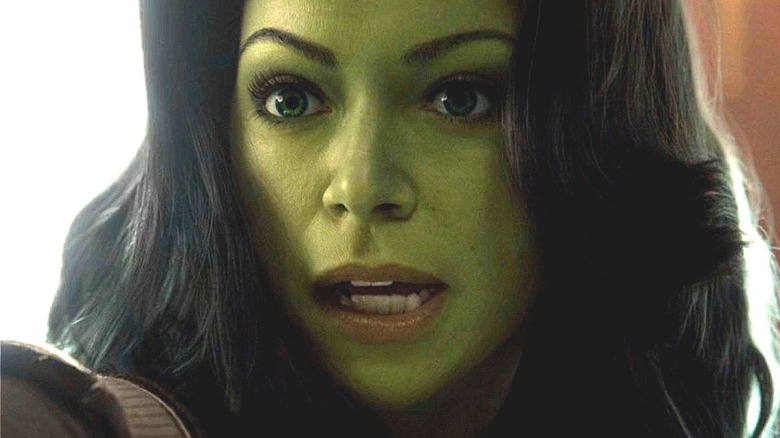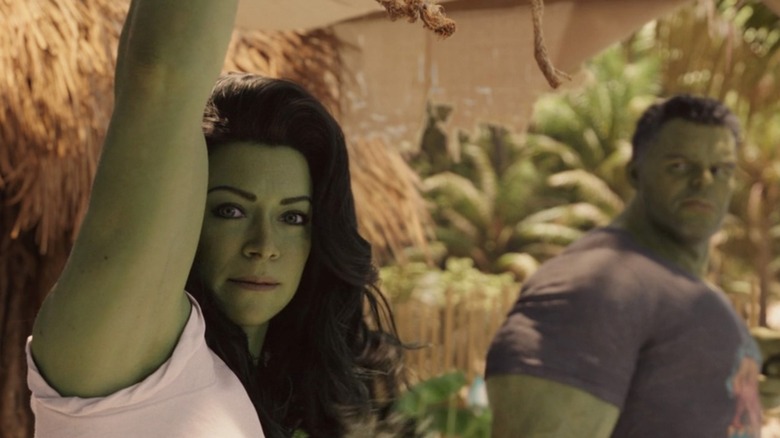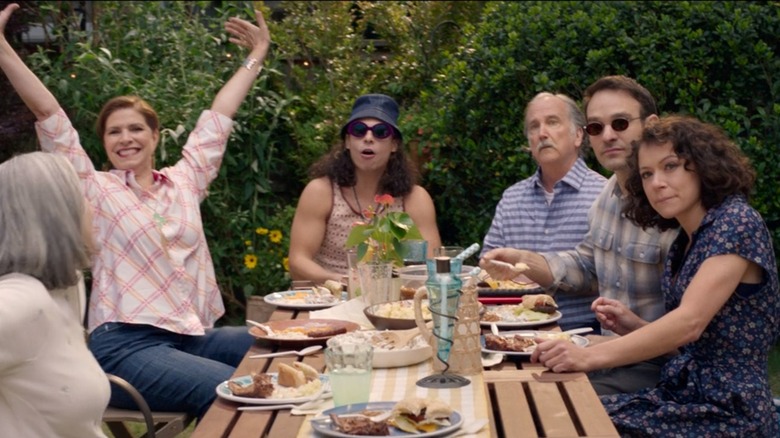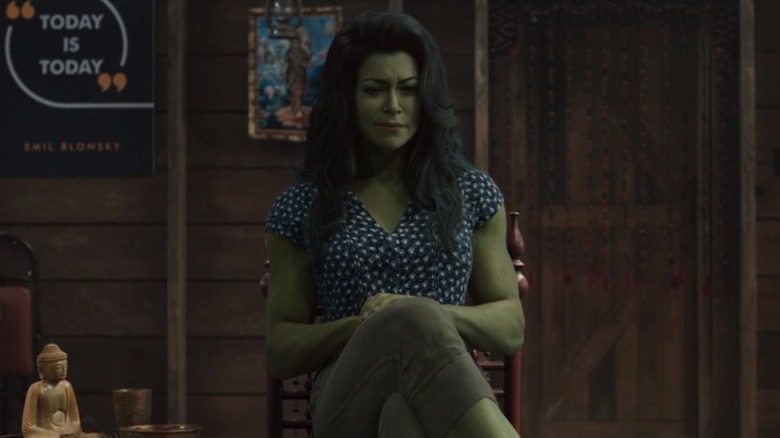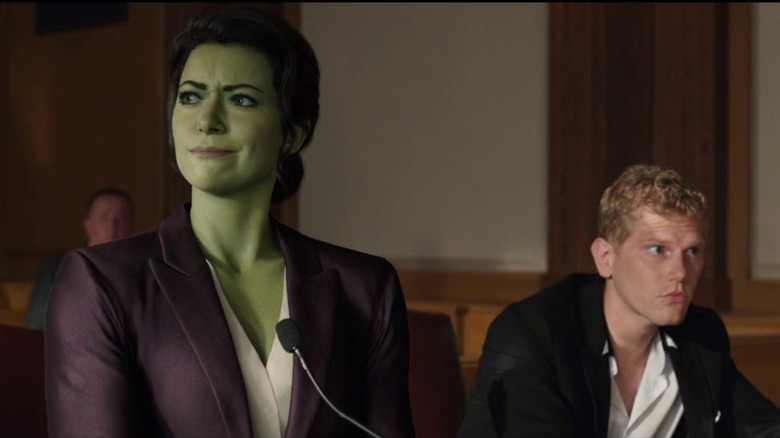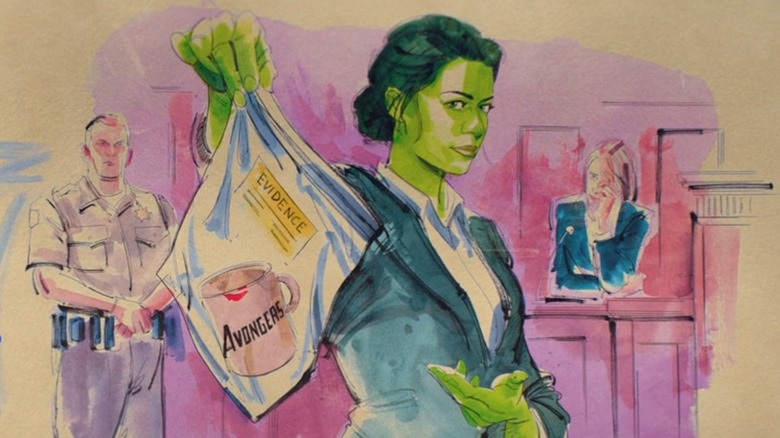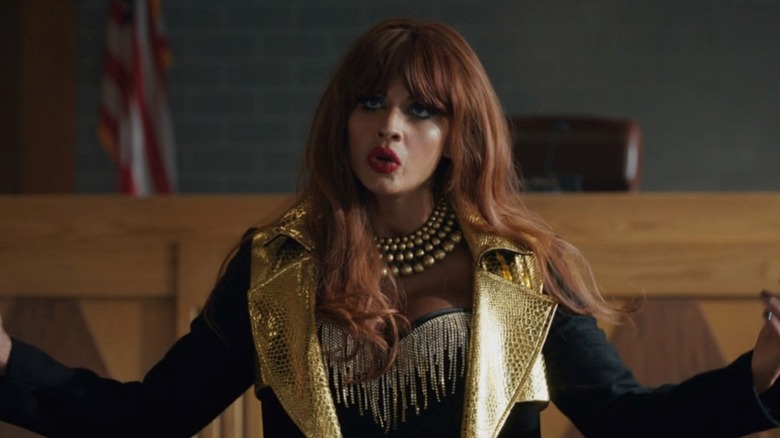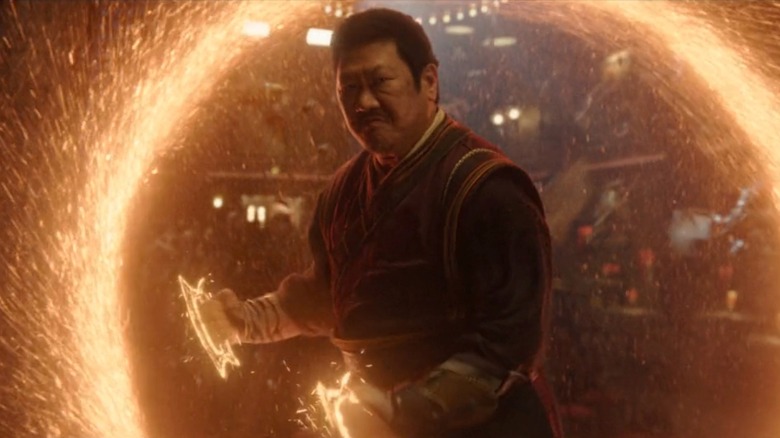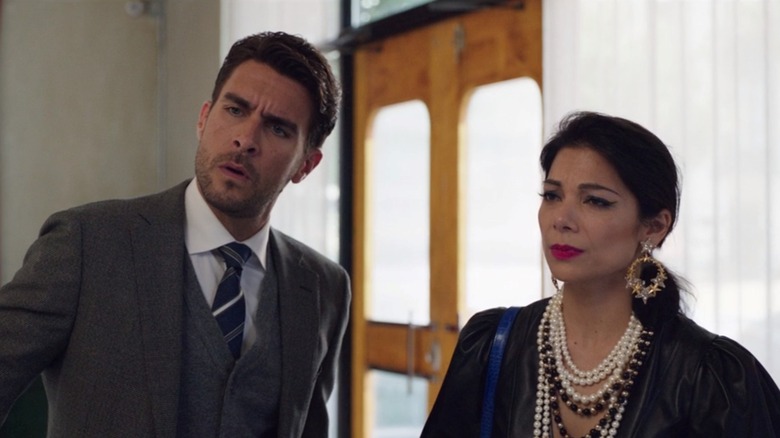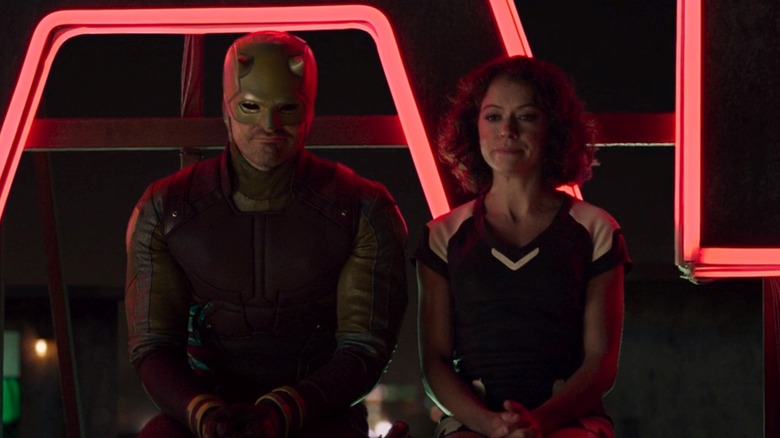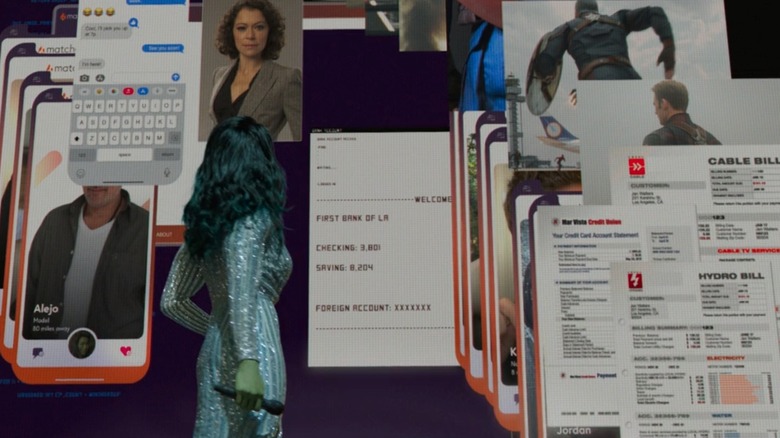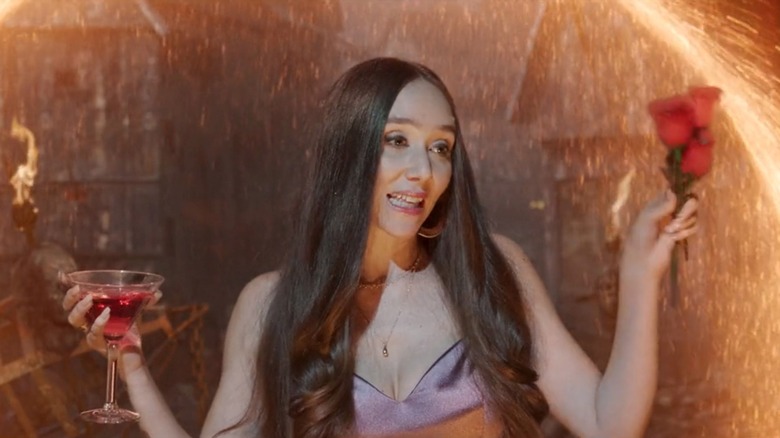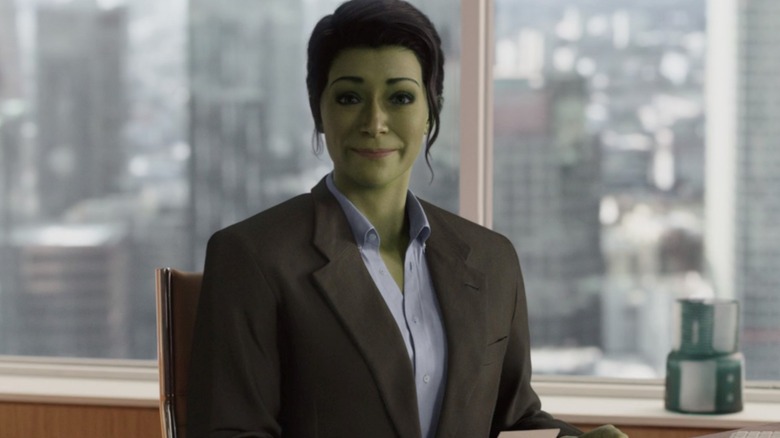The 6 Best And 6 Worst Things About She-Hulk: Attorney At Law
"She-Hulk: Attorney at Law" is a bold departure for the Marvel Cinematic Universe, a savvy genre mash-up combining the comedic legal wranglings of "Ally McBeal" with the superheroic angst and action of "The Incredible Hulk."
Developed for television by Jessica Gao, this 9-episode Disney+ series introduces audiences to Jennifer Walters ("Orphan Black" star Tatiana Maslany), an enthusiastic young lawyer and cousin of Bruce Banner (Mark Ruffalo), the former Avenger now nicknamed Smart Hulk. An accidental transfusion of Bruce's gamma-irradiated blood allows Jennifer to transform into the sensational She-Hulk, and she sets out to smash the glass ceiling — and the fourth wall — as part of her firm's newly developed Superhuman Law division. Unfortunately for Jennifer, "work-life balance" takes on a whole new meaning when you have the super-strength of a Hulk.
Despite a positive response from critics, "She-Hulk" isn't totally in the green. The ambitious series tries to juggle She-Hulk's personal life, her career, and her dawning superheroism amidst a crowded cast — not always with success. These are the best and worst things about "She-Hulk: Attorney at Law." Spoilers ahead.
Best: Breaking the fourth wall
"She-Hulk: Attorney at Law" immediately establishes itself as a different breed of superhero show in the first episode, "A Normal Amount of Rage," when Jennifer Walters breaks the fourth wall to address the audience directly. She-Hulk's awareness of her status as a fictional character has been one of her defining traits since 1989's "Sensational She-Hulk" #1 – beating Deadpool to the metafictional punch by several years.
With the Marvel Cinematic Universe deep into Phase 4, Jennifer's knowing winks to the camera about common superhero tropes — twist endings, special guest stars, fun post-credit scenes — add a rich layer of humor to the series. This all leads to the spectacular, subversive season finale "Whose Show Is This?" where a dissatisfied Jennifer breaks out of her own show to confront the "She-Hulk" writing staff and the mysterious A.I. named K.E.V.I.N. that holds her fictional fate in its hands.
By arguing with K.E.V.I.N. (a nod to MCU head honcho Kevin Feige), She-Hulk takes control over her own story and wins back her agency after being harassed by the hate group Intelligencia. "We smash things," Jennifer explains to K.E.V.I.N., underlining the similarities — and the key difference — between her and her cousin. "Bruce smashes buildings. I smash fourth walls and bad endings."
Worst: Jen's family
Family is important in "She-Hulk." After all, Jennifer Walters is the cousin of an Avenger, and without that familial bond, she never would have been there to pull Bruce Banner out of a deadly car wreck in the first episode, nor receive the accidental blood transfusion that gives her superpowers. Tatiana Maslany and Mark Ruffalo shine in their scenes together, but the rest of Jennifer's family is far from super.
Episode 2, "Superhuman Law," introduces Jennifer's parents, bringing a tonal shift that is more in line with an outdated 1990s sitcom than a modern meta-comedy about a superhero lawyer. Morris (Mark Linn-Baker) and Elaine (Tess Malis Kincaid) are bland, one-joke characters. Morris is the doting dad who supports Jennifer, while Elaine jabs at her daughter's age, size, and single status. Being the parents of a Hulk has a lot of comedic potential, but on the show, it only leads to hokey visual gags, like Jennifer carrying armloads of water jugs into their house.
Another family member who feels like he should have been left on the cutting room floor is Jennifer's underachieving cousin Ched (Nicholas Cirillo). Ched's only ambition on the show is to profit off his famous relative, selling "She-Hulk" merchandise and DJing weddings as The Incredible Ched — as if Jennifer doesn't have enough disappointing men in her life. In this legal comedy, Jennifer's family commits the worst crime of all: being unfunny.
Best: Jennifer's retreat monologue
"You know in high school that friend you have that's, like, cooler than you are?" She-Hulk asks in Episode 7, "The Retreat." Surrounded by supportive Z-list superheroes at Emil Blonsky's lodge, Jennifer Walters unburdens herself with a monologue that reveals the tender heart hiding under her tough green exterior. Though she turns heads when she transforms into the new, "cooler" version of herself, she admits that it feels like cheating, and that she wonders if the people around her so entranced by She-Hulk would care if she was "just Jen." And it pains her, because deep down she knows Jen is great.
Jennifer's lodge monologue is a standout moment in the series, and a showcase for the talents of Emmy Award-winning star Tatiana Maslany. It is no easy task to project vulnerability while sitting across from a man dressed head-to-toe in a porcupine suit. The scene is a perfect encapsulation of Jennifer's internal dilemma in Season 1, and her reluctance to embrace her heroic identity as She-Hulk — and Tatiana Maslany sells every second of it. This moment, more than any supervillain punch-up or even a winking nod to the audience, shows why Maslany is perfect as both Jennifer Walters and She-Hulk.
Worst: She's a bad lawyer
One of the most original aspects of "She-Hulk: Attorney at Law" is right there in the title — the titular superhero has a job. In a sea of billionaire geniuses, space pirates, and rulers of fantasy kingdoms, Jennifer Walters has a professional life that requires her to solve problems as opposed to just punching them away. "She-Hulk" positions itself as a legal comedy, but aside from introducing guest stars for Jennifer to represent in each episode, it rarely feels like a lawyer show. And, what's worse, Jennifer often seems like a bad lawyer.
Talking to Variety, showrunner Jessica Gao said that "one thing that [the writers room] all realized very slowly was none of us are that adept at writing, you know, rousing trial scenes." This is evident watching the series. In Episode 5, Jennifer is sued by Titania, who seeks to trademark the "She-Hulk" name. Jennifer's colleague Mallory Book chides her for being (temporarily) outmaneuvered by the celebrity. And in Episode 9, Jennifer's legal showdown with Matt Murdock (Charlie Cox) is over in minutes when her client admits that he ignored important instructions — a critical detail Jennifer should have known about, but didn't.
While one shouldn't expect 100% legal accuracy in a superhero show featuring Light Elves, the Abomination, and immortal bigamists, it's disappointing that Jennifer comes across as reactive, passive, and clumsy about her job. In the season finale, Jennifer successfully lobbies her case against the artificial intelligence K.E.V.I.N., but it's too little, too late.
Best: The end credits
Whether you're sitting in a theater or watching Disney+ at home, there is one ironclad rule for MCU fans: don't skip the credits. Not only do you not want to miss any exciting post-credit scenes, but the end credit sequences for MCU films and television shows are often visually arresting stories themselves. They can include Easter eggs, underline relevant themes, or just be fun to look at — or, in the case of "She-Hulk," all the above.
"She-Hulk: Attorney at Law" ends every episode with vibrant illustrations by artist Kagan McLeod in the style of courtroom sketches. Lighthearted and charming, the credits include She-Hulk submitting a knock-off "Avongers" mug as evidence in a case, as well as drawings of the reluctant superhero lifting weights on Venice Beach and taking awkward photos with cosplayers. Each episode includes a few bonus sketches relevant to the story, like Episode 5 showcasing Pug's superhero shoe collection or Episode 1 ending with Jennifer showing off her elaborate chart analyzing Captain America's love life.
McLeod's artwork displays rich attention to detail that fits the series perfectly, as do the excellent likenesses of Tatiana Maslany and the rest of the cast. Not only are the courtroom sketch credits on-brand for a show about a lawyer, but the illustrated style is a welcome reminder of She-Hulk's vivid origins as a comic book character.
Worst: Titania
The casting of Jameela Jamil as She-Hulk's archrival Titania seemed like a slam dunk when fans had their first look at Jamil sporting Titania's signature red locks. Best known for her breakthrough role as name-dropping socialite Tahani on "The Good Place," Jamil steps into the designer shoes of the super-strong Titania (a supervillain reimagined for television as a celebrity influencer) with aplomb.
Despite a memorable entrance in the first episode, in which she smashes through the walls of the courtroom just to tussle with the jade giantess, Titania is a perilously underwritten antagonist, with none of the history or character development that has made her a memorable frenemy for Jennifer in the comics. How did Titania get her superpowers? Why does she become obsessed with Jennifer, first attempting to steal the "She-Hulk" name, and later crashing her childhood friend's wedding?
Though Titania appears in five episodes — more than either Emil Blonsky/Abomination and the show's actual main antagonist, tech-bro Todd — her motivations remain murky and one-dimensional. In fact, if you don't pay close attention to a news report in Episode 2, you might completely miss the explanation for why she even crashed Jennifer's court case. To be clear, Jamil is a talented performer, but she (and Titania) deserved better.
Best: The cameos
Episode after episode, "She-Hulk: Attorney at Law" brings colorful guest stars from the wildest, weirdest corners of the Marvel Universe to the screen. Some of these special guests are returning fan-favorites, like Wong (Benedict Wong), Emil Blonsky/The Abomination (Tim Roth), and Matt Murdock/Daredevil (Charlie Cox). But the magic of "She-Hulk" is that we can see what these characters are up to when they're not busy saving the world. What classic TV show is Wong binge-watching? What does a former supervillain like the Abomination do when he's on parole? The answers are as illuminating as they are entertaining.
For longtime fans of Marvel Comics, "She-Hulk" reaches deep into the back issue bins to bring characters to the MCU that might otherwise never get the spotlight on the big or small screen. Fans of the obscure super team the Great Lakes Avengers get a glimpse of their leader, Mr. Immortal, and She-Hulk and Daredevil get the jump on the wannabe hero Leap-Frog. Porcupine will probably never appear in an "Ant-Man and the Wasp" sequel (he battled the duo in the comics), but he is a hilarious guest at Blonsky's supervillain spiritual retreat. The cameos in "She-Hulk" are great fun, and they also help expand the Marvel Cinematic Universe, making it feel like a much bigger place.
Worst: Weak supporting cast
The downside to all the cameos from fan-favorite Marvel characters in "She-Hulk: Attorney at Law" is that they often come at the expense of the show's supporting cast. In setting up Jennifer Walters' family life and professional career, the series introduces a large supporting cast that includes Jennifer's best friend and paralegal Nikki Ramos (Ginger Gonzaga), as well as her new GLK&H colleagues Mallory Book (Renée Elise Goldsberry) and Augustus "Pug" Pugliese (Josh Segarra).
The Goodman, Lieber, Kurtzberg, & Holliway firm and its Superhuman Law division has enormous storytelling potential as an extension of the Marvel Universe, but the ordinary people who work there are easily overshadowed by the flashy guest stars of the week. Nikki Ramos fares best as Jen's fun, fashionista friend, but storylines with the other characters, such as Mallory Book's implied tension with Jennifer in Episode 5, never quite get off the ground. If more time and attention had been paid to Mallory, Pug, or even Luke Jacobson (Griffin Matthews), the MCU's new fashion designer for superheroes, the season would have been stronger.
Best: Daredevil/She-Hulk romance
"She-Hulk" Season 1 explores Jennifer Walters' love life with honesty and humor, even when she's dealing with heartbreak. Modern dating is hard enough without worrying about prospective partners only liking you for your superpowers — or worse, trying to steal your gamma-irradiated blood for evil experiments. So, while it was already exciting to see Charlie Cox reprising the role of Matt Murdock/Daredevil on "She-Hulk," it was an even better surprise to see romance blossom between the MCU's two best lawyers-slash-superheroes. Episode 8, "Ribbit and Rip It," begins with Matt defeating Jen in the courtroom, but later, as they chat over drinks, their chemistry is so palpable that Jennifer breaks the fourth wall to ask the audience, "We're all feeling this, right? It's not just me?"
She-Hulk and Daredevil inevitably clash in their superhero identities, with Charlie Cox and Tatiana Maslany throwing about banter as easily as She-Hulk tosses cars. They bring out the best in each other, with Matt giving Jennifer good advice on balancing her life as a hero and lawyer and Jennifer drawing the brooding Daredevil out of his shell. When they consummate their feelings, the scene is sweet, sensual, and well-earned — plus, it's followed by the hilarious sight of Daredevil's "walk of shame" the next morning, in full costume. In the comics, Matt and Jennifer have both been entangled with various superheroes over the years, but never officially with each other, making their romance in the MCU even more unexpected and rewarding.
Worst: Revenge porn plotline
"She-Hulk" Episode 8, "Ribbit and Rip It," takes a dark turn in its final minutes, with the misogynist online troll collective Intelligencia crashing the Female Lawyer of the Year award ceremony to publicly shame Jennifer. It's established that the devious Josh Miller is an Intelligencia member who stole a sample of Jennifer's blood, but the episode goes even further by having Intelligencia broadcast a recording of Jennifer and Josh's sexual encounter, which he filmed without her consent.
Superhero stories are welcome to tackle serious, adult themes such as misogyny and abuse. For example, Marvel's critically acclaimed series "Jessica Jones" deals openly with Jessica being a sexual assault survivor. But "She-Hulk," even when handling topics like toxic online trolls, is largely a light-hearted comedy, so the sudden tonal change is jarring. The next episode quickly moves on to the aftermath of She-Hulk trashing the gala, with the video's emotional effects on Jennifer glossed over. The season ends with She-Hulk bringing the Intelligencia ringleader to justice, but, overall, the series feels ill-equipped to handle such a serious crime committed against its heroine.
If you or anyone you know has been a victim of sexual assault, help is available. Visit the Rape, Abuse & Incest National Network website or contact RAINN's National Helpline at 1-800-656-HOPE (4673).
Best: Madisynn
"She-Hulk: Attorney at Law" introduces a bunch of strange and exciting comic book characters to the MCU. Besides She-Hulk herself, Titania, Leap-Frog, Mr. Immortal, Man-Bull, and Porcupine all make eye-grabbing first appearances, which makes it even more surprising that the show's breakout character is wholly original. That character is, of course, the one and only Madisynn.
Played by Groundlings alum Patty Guggenheim, Madisynn is introduced in Episode 4 as a perpetually tipsy party girl who hack magician Donny Blaze sends to another dimension. Navigating her way through the underworld (which includes a deal with a demonic goat named Jake), Madisynn stumbles into Wong's home in Kamar-Taj, spoiling his "Sopranos" watch party.
Guggenheim's crackerjack comedic timing makes Madisynn an instantly iconic character and an excellent foil for the more strait-laced "Wongers." Despite appearing in only one episode, Madisynn has taken the internet by storm, with Jessica Gao praising her chemistry with the Sorcerer Supreme and telling Nerdist: "My goal now is to make a Wong and Madisynn Halloween Special!" Madisynn seems unstoppable, but one pressing question remains: Could she defeat Thanos? "I know she could," said Guggenheim.
Worst: The CGI
When the first "She-Hulk: Attorney at Law" trailer hit the internet, fans were underwhelmed by the CGI in the footage. A common refrain was that the effects — especially for She-Hulk, the star of the series — appeared dated and cheap-looking, not at all up to the visual quality expected of a Phase 4 Marvel project. When the series premiered on Disney+ with finished effects, the online response was warmer. Yet, despite improvements, the CGI still falls flat and is overall unconvincing. Tatiana Maslany's spirited performance as Jennifer Walters fades when she becomes She-Hulk, her features and movements stiffened by the VFX. The hero never quite blends in with the setting or her supporting cast, and that's a big problem.
However, when discussing the visual effects on display in "She-Hulk," it is important to recognize the real people responsible for them. According to a Vulture Op-Ed by an anonymous VFX artist, the effects houses that Marvel uses are frequently overworked and understaffed, with Marvel sometimes demanding major changes with extremely short turnaround times. In "She-Hulk" Episode 9, the robotic A.I. in charge of Marvel Studios, K.E.V.I.N., tells She-Hulk to change back into Jennifer off-screen because she "is very expensive" and "the visual effects team has moved onto another project." In context, these attempts at meta-humor at the expense of the VFX teams seem in very poor taste.
